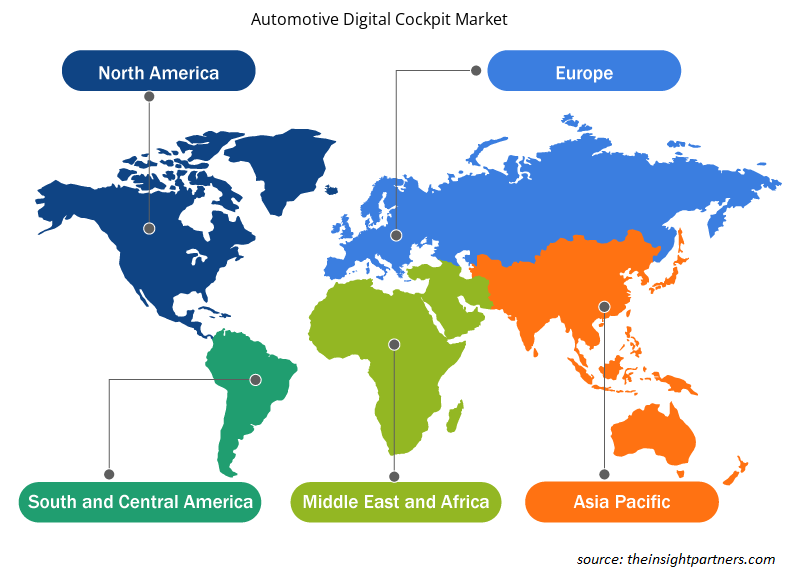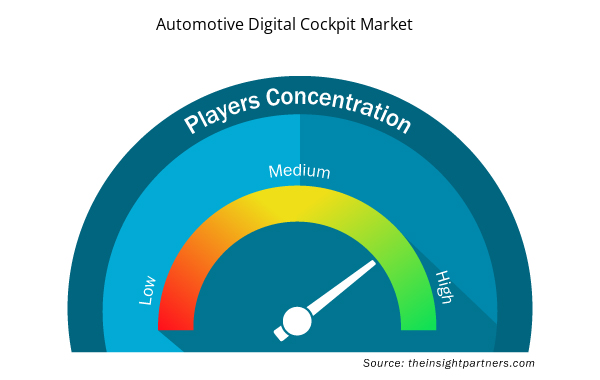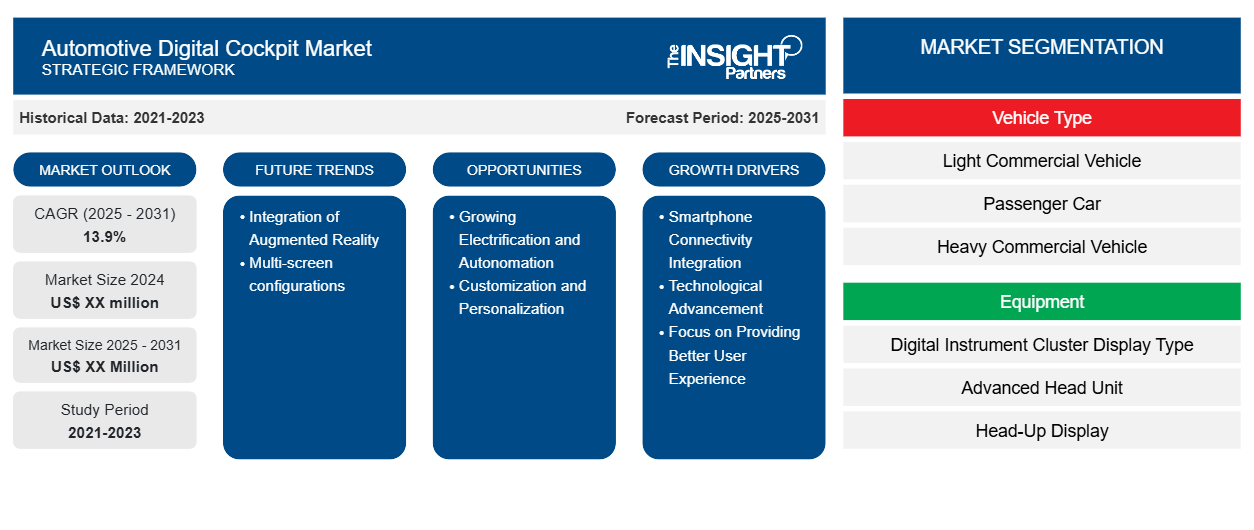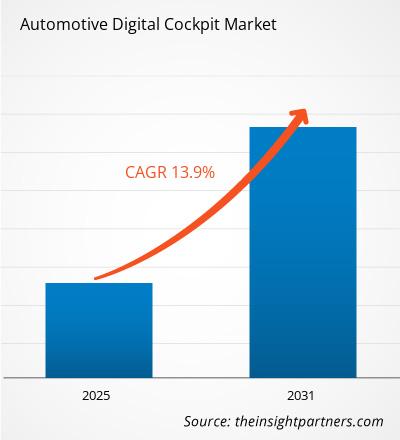Der Markt für digitale Cockpits in der Automobilindustrie soll von 2023 bis 2031 eine durchschnittliche jährliche Wachstumsrate (CAGR) von 13,9 % verzeichnen, wobei die Marktgröße von XX Millionen US-Dollar im Jahr 2023 auf XX Millionen US-Dollar im Jahr 2031 anwachsen soll.
Der Bericht ist nach Fahrzeugtyp (leichtes Nutzfahrzeug, Pkw, schweres Nutzfahrzeug) und Ausstattung (Anzeigetyp des digitalen Kombiinstruments, erweiterte Haupteinheit, Head-Up-Display (HUD), kamerabasiertes Fahrerüberwachungssystem) segmentiert. Die globale Analyse ist weiter auf regionaler Ebene und nach wichtigen Ländern aufgeschlüsselt. Der Bericht bietet den Wert in USD für die oben genannte Analyse und Segmente.
Zweck des Berichts
Der Bericht Automotive Digital Cockpit Market von The Insight Partners zielt darauf ab, die aktuelle Landschaft und das zukünftige Wachstum sowie die wichtigsten treibenden Faktoren, Herausforderungen und Chancen zu beschreiben. Dies wird verschiedenen Geschäftspartnern Einblicke geben, wie zum Beispiel:
- Technologieanbieter/-hersteller: Um die sich entwickelnde Marktdynamik zu verstehen und die potenziellen Wachstumschancen zu kennen, damit sie fundierte strategische Entscheidungen treffen können.
- Investoren: Durchführung einer umfassenden Trendanalyse hinsichtlich der Marktwachstumsrate, der finanziellen Marktprognosen und der Chancen entlang der Wertschöpfungskette.
- Regulierungsbehörden: Zur Regulierung von Richtlinien und Überwachungsaktivitäten auf dem Markt mit dem Ziel, Missbrauch zu minimieren, das Vertrauen der Anleger zu bewahren und die Integrität und Stabilität des Marktes aufrechtzuerhalten.
Marktsegmentierung für digitales Cockpit im Automobilbereich
Fahrzeugtyp
- Leichtes Nutzfahrzeug
- Pkw
- Schweres Nutzfahrzeug
Ausrüstung
- Anzeigetyp des digitalen Kombiinstruments
- Fortschrittliche Haupteinheit
- Head-Up-Display
- Kamerabasiertes Fahrerüberwachungssystem
Passen Sie diesen Bericht Ihren Anforderungen an
Sie erhalten kostenlos individuelle Anpassungen an jedem Bericht, einschließlich Teilen dieses Berichts oder einer Analyse auf Länderebene, eines Excel-Datenpakets sowie tolle Angebote und Rabatte für Start-ups und Universitäten.
- Holen Sie sich die wichtigsten Markttrends aus diesem Bericht.Dieses KOSTENLOSE Beispiel umfasst eine Datenanalyse von Markttrends bis hin zu Schätzungen und Prognosen.
Wachstumstreiber auf dem Markt für digitale Cockpits in der Automobilindustrie
- Integration der Smartphone-Konnektivität: Dies ist einer der treibenden Faktoren auf dem Markt für digitale Cockpits im Automobilbereich. Immer mehr Autofahrer verlangen nach einer Integration der Smartphone-Konnektivität in ihr Auto. Verbraucher begrüßen nahtlose Konnektivitätsoptionen, die es ihnen ermöglichen, ihre Mobilgeräte auch während der Fahrt zu nutzen und so das gesamte Benutzererlebnis zu verbessern.
- Technologischer Fortschritt: Das Segment der digitalen Cockpits folgt einem dominanten Trend rasanter technologischer Veränderungen. In Bezug auf digitale Cockpits, intelligente Beleuchtungssysteme und verbesserten Sitzkomfort prägen Innovationen die Erwartungen der Verbraucher und erhöhen dementsprechend die Nachfrage nach modernen Innenräumen.
- Fokus auf ein besseres Benutzererlebnis: Verbraucher fordern heute eine nahtlose Integration von Infotainment, Navigation und Fahrzeugeinstellungen, ohne dass ihr Komfort beeinträchtigt wird. Moderne Cockpits bieten eine attraktive, anpassbare Schnittstelle, die die Verwendung von Displays je nach Vorliebe oder Bequemlichkeit ermöglicht und so den Komfort und die Zufriedenheit des Benutzers erhöht. Darüber hinaus steigt mit der Weiterentwicklung der Automobiltechnologie der Bedarf an Multifunktions-Touchscreens sowie Head-up-Displays, die Echtzeitdaten direkt in das Sichtfeld des Fahrers liefern. Neben der Gewährleistung der Sicherheit durch geringere Ablenkung macht derselbe Aspekt das Fahrerlebnis weitaus ansprechender, und daher ist ein digitales Cockpit ein wesentlicher Bestandteil moderner Automobile.
- Integration fortschrittlicher Fahrerassistenzsysteme: Dies hat dazu geführt, dass Unternehmen mehr in digital fortschrittliche Cockpits für die ADAS-Integration investieren. Die Systeme in den Fahrzeugen nutzen eine Mischung aus Sensoren und Technologien, um eine bessere Fahrzeugsicherheit zu gewährleisten. Digitale Cockpits, die mit Spurhalteassistenten, adaptiver Geschwindigkeitsregelung oder sogar Kollisionsvermeidungssystemen ausgestattet sind, dienen dazu, den Fahrern bei solchen Sicherheitsvorfällen sehr zeitnah Informationen und Warnungen zu liefern. Diese Integration kommt nicht nur der Aufmerksamkeit des Fahrers zugute, sondern erleichtert auch den Übergang zum autonomen Fahren. Da der regulatorische Druck und der Wunsch der Verbraucher nach sichereren Fahrzeugen zunehmen, wird die Einführung digitaler Cockpits, die ADAS-Funktionen unterstützen, an Dynamik gewinnen.
Zukünftige Trends auf dem Markt für digitale Cockpits in der Automobilindustrie
- Integration von Augmented Reality: Es zeichnet sich auch ein Trend ab, Augmented Reality in digitale Cockpits von Autos zu integrieren. AR-Technologie kann das Fahrerlebnis verbessern, indem sie digitale Informationen in die reale Ansicht einblendet und dem Fahrer wichtige Navigationshinweise und Sicherheitswarnungen liefert. Ein Beispiel hierfür ist ein AR-Head-up-Display, das direkt auf die Windschutzscheibe projiziert wird, während der Fahrer sich zur Orientierung auf die Straße konzentriert. Dies kann die Situationswahrnehmung verbessern und das Fahrvergnügen und das futuristische Gefühl verstärken. Da sich AR-Technologie weiterentwickelt und zum Mainstream wird, wird sie wahrscheinlich standardmäßig in digitale Cockpits neuer Fahrzeuge integriert werden.
- Multi-Screen-Konfigurationen: Multi-Screen-Konfigurationen gewinnen auf dem Markt für digitale Cockpits im Automobilbereich an Bedeutung. Immer mehr Autodesigns enthalten mehrere Displays für unterschiedliche Zwecke, darunter einen zentralen Infotainment-Bildschirm, ein fahrerorientiertes Kombiinstrument und ein Beifahrerdisplay. Dieser Trend wird das Multiplexing verbessern, sodass der Fahrer gleichzeitig Navigation, Audio und Fahrzeugdaten sehen kann. Wenn außerdem zwei Bildschirme für die Beifahrer verwendet werden, ergeben sich Möglichkeiten für Unterhaltung und Interaktion während der Fahrt. Angesichts der steigenden Ansprüche der Verbraucher an Technologie in Autos wird die Multi-Screen-Anordnung im digitalen Cockpit zum Markenzeichen zukünftiger Autocockpits, da sie viel funktionaler und flexibler ist.
Marktchancen für digitale Cockpits in der Automobilindustrie
- Zunehmende Elektrifizierung und Autonomie : Die rasante Entwicklung von Elektro- und autonomen Fahrzeugen eröffnet den Markt für digitale Cockpits. Da diese Fahrzeuge weniger physische Bedienelemente haben und stärker auf Technologie angewiesen sind, entsteht eine größere Nachfrage nach fortschrittlichen digitalen Cockpit-Lösungen, die intuitive Schnittstellen und erweiterte Funktionen bieten. Hersteller können innovative Displays entwickeln, die sich an den Fahrmodus anpassen und unterschiedliche Informations- und Bedienlayouts für manuelles Fahren und autonomen Betrieb bieten. Dieser Übergang bietet Spielraum für die Gestaltung interaktiverer und umfassenderer Erlebnisse, die den sich ändernden Bedürfnissen von Fahrer und Beifahrer gerecht werden können. Digitale Cockpits werden damit zu einem der wichtigsten Bestandteile des Automobildesigns der Zukunft.
- Anpassung und Personalisierung : Die Nachfrage nach Anpassung und Personalisierung eines digitalen Cockpits im Auto wächst. Da Verbraucher nach einzigartigen Erlebnissen suchen, können Hersteller Datenanalyse und maschinelles Lernen nutzen, um maßgeschneiderte Schnittstellen zu erstellen, die sich an die individuellen Vorlieben des Fahrers anpassen. Funktionen wie personalisierte Themen, Sitzpräferenzen und individuelle Infotainment-Optionen können die Einbindung und Zufriedenheit der Benutzer verbessern. Darüber hinaus können modulare Designs, die es Benutzern ermöglichen, bestimmte Funktionen oder Ästhetik auszuwählen, Marken in einem wettbewerbsintensiven Markt von der Masse abheben. Da die Nachfrage nach personalisierten Erlebnissen wächst, werden die Marktanteile wahrscheinlich von den Herstellern erobert, die in maßgeschneiderte digitale Cockpit-Lösungen investieren.
Regionale Einblicke in den Markt für digitale Cockpits in der Automobilindustrie
Die regionalen Trends und Faktoren, die den Markt für digitale Cockpits im Automobilbereich während des gesamten Prognosezeitraums beeinflussen, wurden von den Analysten von Insight Partners ausführlich erläutert. In diesem Abschnitt werden auch die Marktsegmente und die Geografie des Marktes für digitale Cockpits im Automobilbereich in Nordamerika, Europa, im asiatisch-pazifischen Raum, im Nahen Osten und Afrika sowie in Süd- und Mittelamerika erörtert.

- Erhalten Sie regionale Daten zum Markt für digitale Cockpits in der Automobilindustrie
Umfang des Marktberichts zum digitalen Cockpit für Kraftfahrzeuge
| Berichtsattribut | Details |
|---|---|
| Marktgröße im Jahr 2023 | XX Millionen US-Dollar |
| Marktgröße bis 2031 | XX Millionen US-Dollar |
| Globale CAGR (2023 - 2031) | 13,9 % |
| Historische Daten | 2021-2022 |
| Prognosezeitraum | 2024–2031 |
| Abgedeckte Segmente | Nach Fahrzeugtyp
|
| Abgedeckte Regionen und Länder | Nordamerika
|
| Marktführer und wichtige Unternehmensprofile |
|
Dichte der Marktteilnehmer für digitale Cockpits im Automobilbereich: Die Auswirkungen auf die Geschäftsdynamik verstehen
Der Markt für digitale Cockpits im Automobilbereich wächst rasant, angetrieben durch die steigende Nachfrage der Endnutzer aufgrund von Faktoren wie sich entwickelnden Verbraucherpräferenzen, technologischen Fortschritten und einem größeren Bewusstsein für die Vorteile des Produkts. Mit steigender Nachfrage erweitern Unternehmen ihr Angebot, entwickeln Innovationen, um die Bedürfnisse der Verbraucher zu erfüllen, und nutzen neue Trends, was das Marktwachstum weiter ankurbelt.
Die Marktteilnehmerdichte bezieht sich auf die Verteilung der Firmen oder Unternehmen, die in einem bestimmten Markt oder einer bestimmten Branche tätig sind. Sie gibt an, wie viele Wettbewerber (Marktteilnehmer) in einem bestimmten Marktraum im Verhältnis zu seiner Größe oder seinem gesamten Marktwert präsent sind.
Die wichtigsten Unternehmen auf dem Markt für digitale Cockpits in der Automobilindustrie sind:
- Robert Bosch GmbH
- Denso Corporation
- Visteon
- Aptiv
- Harman International
- Pioneer-Unternehmen
Haftungsausschluss : Die oben aufgeführten Unternehmen sind nicht in einer bestimmten Reihenfolge aufgeführt.

- Überblick über die wichtigsten Akteure auf dem Markt für digitale Cockpits im Automobilbereich
Wichtige Verkaufsargumente
- Umfassende Abdeckung: Der Bericht deckt die Analyse von Produkten, Diensten, Typen und Endbenutzern des Marktes für digitale Cockpits im Automobilbereich umfassend ab und bietet einen ganzheitlichen Überblick.
- Expertenanalyse: Der Bericht basiert auf dem umfassenden Verständnis von Branchenexperten und Analysten.
- Aktuelle Informationen: Der Bericht stellt durch die Abdeckung aktueller Informationen und Datentrends Geschäftsrelevanz sicher.
- Anpassungsoptionen: Dieser Bericht kann angepasst werden, um spezifische Kundenanforderungen zu erfüllen und die Geschäftsstrategien optimal anzupassen.
Der Forschungsbericht zum Markt für digitale Cockpits im Automobilbereich kann daher dabei helfen, die Branchensituation und Wachstumsaussichten zu entschlüsseln und zu verstehen. Obwohl es einige berechtigte Bedenken geben kann, überwiegen die allgemeinen Vorteile dieses Berichts tendenziell die Nachteile.
- Historische Analyse (2 Jahre), Basisjahr, Prognose (7 Jahre) mit CAGR
- PEST- und SWOT-Analyse
- Marktgröße Wert/Volumen – Global, Regional, Land
- Branche und Wettbewerbsumfeld
- Excel-Datensatz



Report Coverage
Revenue forecast, Company Analysis, Industry landscape, Growth factors, and Trends

Segment Covered
This text is related
to segments covered.

Regional Scope
North America, Europe, Asia Pacific, Middle East & Africa, South & Central America

Country Scope
This text is related
to country scope.
Häufig gestellte Fragen
Some of the customization options available based on the request are an additional 3-5 company profiles and country-specific analysis of 3-5 countries of your choice. Customizations are to be requested/discussed before making final order confirmation, as our team would review the same and check the feasibility.
The report can be delivered in PDF/PPT format; we can also share excel dataset based on the request.
The Automotive Digital Cockpit Market is estimated to witness a CAGR of 13.9% from 2023 to 2031
The major factors driving the Automotive Digital Cockpit Market are: Integration of Smartphone Connectivity#Technological Advancements
Shift Towards Minimalist Designs is the key future trend of the Automotive Digital Cockpit Market
The leading players operating in the Automotive Digital Cockpit Market include Robert Bosch GmbH, Denso Corporation, Visteon, Aptiv, Harman International, Pioneer Corporation, Nisshinbo Brake Inc, Continental AG, ZF Friedrichshafen AG, Federal Mogul, Hyundai Mobis
Trends and growth analysis reports related to Automotive and Transportation : READ MORE..
The List of Companies
1. Continental AG
2. Denso Corporation
3. Faurecia
4. Garmin Ltd.
5. JVC Kenwood Corporation
6. Panasonic Corporation
7. Robert Bosch GmBH
8. Samsung Corporation (Harman International)
9. Tieto
10. Visteon Corporation
The Insight Partners performs research in 4 major stages: Data Collection & Secondary Research, Primary Research, Data Analysis and Data Triangulation & Final Review.
- Data Collection and Secondary Research:
As a market research and consulting firm operating from a decade, we have published and advised several client across the globe. First step for any study will start with an assessment of currently available data and insights from existing reports. Further, historical and current market information is collected from Investor Presentations, Annual Reports, SEC Filings, etc., and other information related to company’s performance and market positioning are gathered from Paid Databases (Factiva, Hoovers, and Reuters) and various other publications available in public domain.
Several associations trade associates, technical forums, institutes, societies and organization are accessed to gain technical as well as market related insights through their publications such as research papers, blogs and press releases related to the studies are referred to get cues about the market. Further, white papers, journals, magazines, and other news articles published in last 3 years are scrutinized and analyzed to understand the current market trends.
- Primary Research:
The primarily interview analysis comprise of data obtained from industry participants interview and answers to survey questions gathered by in-house primary team.
For primary research, interviews are conducted with industry experts/CEOs/Marketing Managers/VPs/Subject Matter Experts from both demand and supply side to get a 360-degree view of the market. The primary team conducts several interviews based on the complexity of the markets to understand the various market trends and dynamics which makes research more credible and precise.
A typical research interview fulfils the following functions:
- Provides first-hand information on the market size, market trends, growth trends, competitive landscape, and outlook
- Validates and strengthens in-house secondary research findings
- Develops the analysis team’s expertise and market understanding
Primary research involves email interactions and telephone interviews for each market, category, segment, and sub-segment across geographies. The participants who typically take part in such a process include, but are not limited to:
- Industry participants: VPs, business development managers, market intelligence managers and national sales managers
- Outside experts: Valuation experts, research analysts and key opinion leaders specializing in the electronics and semiconductor industry.
Below is the breakup of our primary respondents by company, designation, and region:

Once we receive the confirmation from primary research sources or primary respondents, we finalize the base year market estimation and forecast the data as per the macroeconomic and microeconomic factors assessed during data collection.
- Data Analysis:
Once data is validated through both secondary as well as primary respondents, we finalize the market estimations by hypothesis formulation and factor analysis at regional and country level.
- Macro-Economic Factor Analysis:
We analyse macroeconomic indicators such the gross domestic product (GDP), increase in the demand for goods and services across industries, technological advancement, regional economic growth, governmental policies, the influence of COVID-19, PEST analysis, and other aspects. This analysis aids in setting benchmarks for various nations/regions and approximating market splits. Additionally, the general trend of the aforementioned components aid in determining the market's development possibilities.
- Country Level Data:
Various factors that are especially aligned to the country are taken into account to determine the market size for a certain area and country, including the presence of vendors, such as headquarters and offices, the country's GDP, demand patterns, and industry growth. To comprehend the market dynamics for the nation, a number of growth variables, inhibitors, application areas, and current market trends are researched. The aforementioned elements aid in determining the country's overall market's growth potential.
- Company Profile:
The “Table of Contents” is formulated by listing and analyzing more than 25 - 30 companies operating in the market ecosystem across geographies. However, we profile only 10 companies as a standard practice in our syndicate reports. These 10 companies comprise leading, emerging, and regional players. Nonetheless, our analysis is not restricted to the 10 listed companies, we also analyze other companies present in the market to develop a holistic view and understand the prevailing trends. The “Company Profiles” section in the report covers key facts, business description, products & services, financial information, SWOT analysis, and key developments. The financial information presented is extracted from the annual reports and official documents of the publicly listed companies. Upon collecting the information for the sections of respective companies, we verify them via various primary sources and then compile the data in respective company profiles. The company level information helps us in deriving the base number as well as in forecasting the market size.
- Developing Base Number:
Aggregation of sales statistics (2020-2022) and macro-economic factor, and other secondary and primary research insights are utilized to arrive at base number and related market shares for 2022. The data gaps are identified in this step and relevant market data is analyzed, collected from paid primary interviews or databases. On finalizing the base year market size, forecasts are developed on the basis of macro-economic, industry and market growth factors and company level analysis.
- Data Triangulation and Final Review:
The market findings and base year market size calculations are validated from supply as well as demand side. Demand side validations are based on macro-economic factor analysis and benchmarks for respective regions and countries. In case of supply side validations, revenues of major companies are estimated (in case not available) based on industry benchmark, approximate number of employees, product portfolio, and primary interviews revenues are gathered. Further revenue from target product/service segment is assessed to avoid overshooting of market statistics. In case of heavy deviations between supply and demand side values, all thes steps are repeated to achieve synchronization.
We follow an iterative model, wherein we share our research findings with Subject Matter Experts (SME’s) and Key Opinion Leaders (KOLs) until consensus view of the market is not formulated – this model negates any drastic deviation in the opinions of experts. Only validated and universally acceptable research findings are quoted in our reports.
We have important check points that we use to validate our research findings – which we call – data triangulation, where we validate the information, we generate from secondary sources with primary interviews and then we re-validate with our internal data bases and Subject matter experts. This comprehensive model enables us to deliver high quality, reliable data in shortest possible time.


 Holen Sie sich ein kostenloses Muster für diesen Bericht
Holen Sie sich ein kostenloses Muster für diesen Bericht